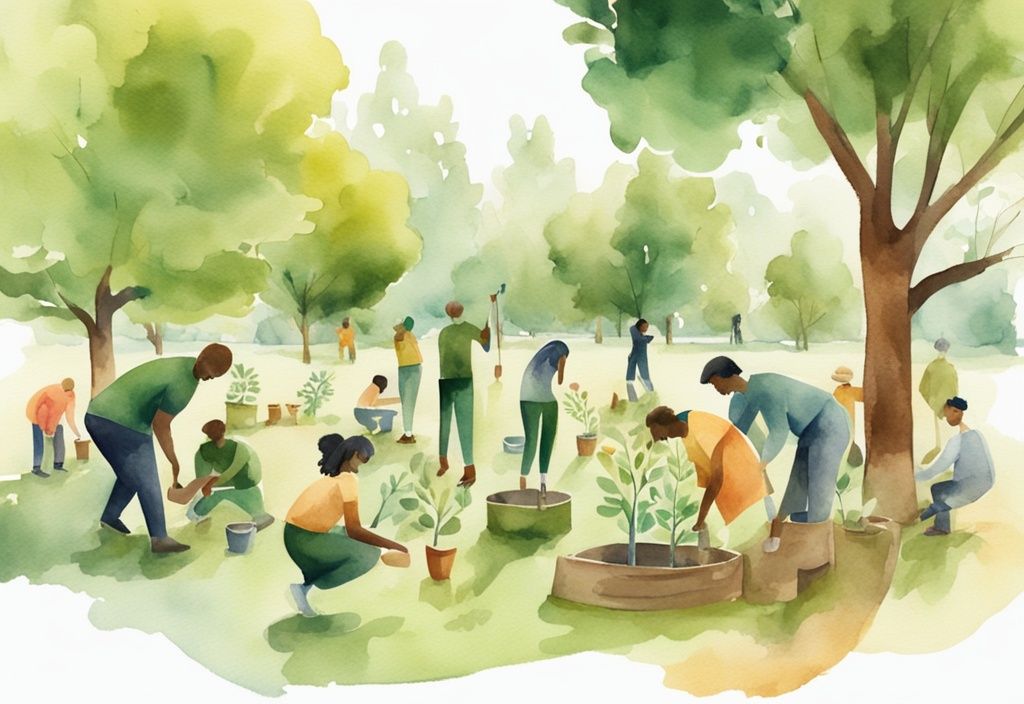Explore and Enjoy Eco Friendly Activities for a Greener Future
Did you know that you have the power to make a substantial impact on our environment? Well, the fact is that your everyday actions can significantly contribute to a greener planet. As a passionate advocate for sustainable living, I’m thrilled to introduce you to our guide for eco-friendly activities in 2024.
This guide will equip you with practical tips on everything from smart energy use to home gardening—small choices and habits that cumulatively result in a healthier home and, crucially, a healthier planet. By embracing eco-friendly activities, you become part of a global movement that’s as much about taking care of your health as it is about safeguarding our planet.
Whether you’re stepping onto the path of sustainable living for the first time or want to broaden your green habits, I encourage you to explore the life-changing potential of these actions. After all, the journey towards a non-toxic, greener lifestyle is one of the most rewarding journeys you’ll ever embark on. Let’s make a difference, starting today!
Introduction to Eco-Friendly Activities
Understanding Eco-Friendly Activities
Eco-friendly activities are actions that conserve and preserve our precious natural resources while minimizing harm to the environment. These practices focus on reducing ecological footprints through sustainable choices and mindful decision-making. By engaging in eco-friendly activities, we collectively foster a healthier planet.
For example, composting organic waste reduces landfill use, recycling materials decreases the need for raw resource extraction, and conserving water helps protect essential habitats. Growing a garden can support biodiversity, while using renewable energy sources like solar or wind power lessens our reliance on fossil fuels. Each of these actions contributes to reducing pollution, mitigating climate change, and preserving ecosystems.
Practicing eco-friendly activities addresses critical environmental issues, such as climate change, deforestation, and pollution. By adopting these sustainable habits, we create a lasting positive impact, ensuring a more sustainable future for generations to come.
Why Consider Eco-Friendly Activities?
Embracing eco-friendly activities offers a wealth of benefits, both economical and environmental. Economically, you can enjoy lower energy bills and reduced consumption of costly disposable goods. Investing in renewable energy solutions and energy-efficient appliances also leads to significant long-term savings.
On the environmental front, eco-friendly activities help reduce carbon emissions, conserve natural resources, and minimize landfill waste. By reducing our reliance on fossil fuels and embracing sustainable practices, we can significantly diminish our carbon footprints, supporting the health of our ecosystems.
Socially, these activities foster a sense of community well-being and collective responsibility toward protecting the environment. Engaging in local eco-friendly projects, such as community gardens and environmental clean-ups, strengthens community bonds and promotes a shared commitment to sustainability.
With the urgency of current environmental issues, the global community is increasingly advocating for more sustainable practices. Time is of the essence. Immediate actions are needed to combat climate change, resource depletion, and ecological degradation. By integrating eco-friendly activities into daily life, you contribute to creating a sustainable future and inspire others to join the cause.
Invalid YouTube video ID
Engaging Eco-Friendly Home Practices
Engaging in eco-friendly activities at home not only benefits the environment but also brings a sense of fulfillment and connection to nature. Here are some home practices that align with sustainable living:
Gardening and Plant Care
Growing Your Own Garden: Offset Carbon Emissions and Support Bees
Creating a vegetable or flower garden is a fulfilling eco-friendly activity. By cultivating a garden, you enhance local biodiversity and enjoy fresh produce, all while supporting bee populations through pollinator-friendly plants. If you’re looking for tips on sustainable gardening practices, you can learn more about minimizing your impact on the earth here. Personally, I’ve found that selecting native plants and seasonal vegetables reduces the need for chemical fertilizers and extensive watering, making the garden more sustainable.
Engaging in organic gardening practices ensures minimal environmental impact, turning your garden into a haven for local wildlife. Plus, the joy of harvesting homegrown vegetables brings a level of satisfaction that’s incomparable. Imagine biting into a crisp carrot or a juicy tomato that you nurtured from seed—it’s a wonderful way to eat fresh and live sustainably.
Indoor Herb Gardening: A Beginner’s Guide
Starting an indoor herb garden is another simple yet effective eco-friendly activity. I remember starting mine with easy-to-grow herbs like basil, mint, and thyme. Planting them in mason jars or small pots and placing them in a sunny spot made the process so seamless.
Ensure proper drainage to prevent root rot and regularly water and prune your plants. This not only encourages healthy growth but also adds a touch of nature to your home. Personally, having fresh herbs at my fingertips has completely transformed my cooking, making it both flavorful and eco-conscious. If you are looking to explore more natural flavors, consider trying some popular ginger tea brands to add to your collection.
Composting 101: Create a Compost Bin and Reduce Emissions
Composting is an essential eco-friendly activity that significantly reduces methane emissions and minimizes landfill waste. Starting with an appropriate compost bin and finding a good location in your yard is the first step. I began by collecting organic waste such as vegetable peels, eggshells, and coffee grounds. Layering these with yard waste like leaves and grass clippings and turning the compost occasionally aerates it and speeds up decomposition.
The nutrient-rich compost that results can be used to enrich your garden soil, promoting healthier plant growth without needing chemical fertilizers. By composting, you contribute to a circular economy, helping to tackle environmental issues effectively. Imagine the satisfaction of turning your kitchen scraps into something that enriches your garden—that’s sustainable living at its best!
Easy DIY Eco-Friendly Projects
Homemade zero-waste products are a practical way to embrace eco-friendly activities, reducing both harmful chemicals and emissions. By creating these products, you not only contribute to environmental preservation but also ensure a healthier home environment.
Recycle, Reuse, Upcycle: An Essential Guide
Creating Homemade Zero-Waste Products
DIY Cleaning Solutions:
-
All-Purpose Cleaner: Mix equal parts of water and white vinegar with a few drops of essential oil in a spray bottle.
Use it for surfaces like countertops and windows. I’ve found that adding a bit of lemon essential oil not only uplifts the scent but also boosts its cleaning power. -
Furniture Polish: Combine one part lemon juice with two parts olive oil.
Apply a small amount on a soft cloth to polish wooden furniture. This recipe works wonders on my antique dresser!
Personal Care Items:
-
Toothpaste: Create your own by blending baking soda with coconut oil and a drop of peppermint essential oil for freshness.
This simple mixture has replaced store-bought toothpaste in my household, and we love it. -
Lip Balm: Melt together equal parts beeswax and shea butter.
Add a splash of coconut oil and a drop of essential oil for scent; pour into small containers to set. These balms are a hit in my family, providing moisture without any harmful additives.
Transform Old into New: Upcycling Project Ideas
Upcycling is a creative and sustainable way to repurpose items, extending their life and reducing waste. These projects can turn seemingly useless objects into functional or decorative pieces, showcasing the essence of eco-friendly activities.

Upcycling Projects:
-
Tote Bags from Old T-shirts: Cut sleeves off the T-shirt and the neckline to create handles.
Sew the bottom hem closed to form a sturdy tote bag.
I have a collection of these reusable bags, each with its own story. -
Decorative Storage from Jars: Clean old jars and paint them in your favorite colors or designs.
Use them to store kitchen staples or desktop items like pens and clips.
These jars add a personalized touch to my kitchen.
Promote Eco-Friendly Entrepreneurship:
Use your upcycled creations as a stepping stone into eco-friendly entrepreneurship.
Platforms like Etsy provide a marketplace where you can sell your crafts, promoting sustainable living while earning an income.
This not only encourages reuse but also educates others on the importance of eco-friendly activities, fostering a collective responsibility towards the environment. My journey started with just a few homemade products, and now it’s a fulfilling endeavor that supports my passion for sustainability.
Saving Energy, the Eco-Friendly Way
Renewable Energy Sources and Their Benefits
Incorporating renewable energy sources like solar, wind, and hydro power into our daily lives is an essential part of embracing eco-friendly activities. These energy sources rely on natural processes that are naturally replenished, offering a sustainable alternative to traditional fossil fuels.
- Solar Power: Embracing solar panels to convert sunlight into electricity helps reduce reliance on coal and gas.
- Wind Power: Wind turbines capture wind energy to produce electricity, providing a clean and sustainable energy source.
- Hydro Power: Using flowing water to generate electricity, significantly minimizes environmental impact compared to conventional power plants.
Integrating renewable energy at home, such as installing solar panels or small wind turbines, not only cuts down energy bills but also significantly reduces our carbon footprints. These steps pave the way for a truly eco-friendly lifestyle.
Improving Home Insulation for a Greener Home
Enhancing home insulation stands out as a fundamental eco-friendly activity that boosts energy efficiency. Proper insulation keeps homes warm during winter and cool in summer, thereby reducing the need for excessive heating or cooling.
- Sealing Draughts: Utilize weather stripping and caulk to seal any gaps around windows and doors to prevent air leaks.
- Adding Insulation: Adding insulation in attics, walls, and floors helps retain indoor temperatures effectively.
- Double-Glazed Windows: Double-glazed windows minimize heat loss and condensation, improving insulation.
- Radiator Foil: By placing foil behind radiators, heat reflects back into the room, improving heating efficiency.
Regular maintenance, such as servicing boilers and checking for insulation damage, ensures your home remains energy-efficient throughout the year.
Steps to Conserve Water at Home
Water conservation embodies core eco-friendly activities, preserving this vital resource and cutting down on utility bills. Small yet impactful actions can significantly contribute to sustainability.
- Fixing Leaks: Quickly repairing leaky faucets and toilets helps prevent water wastage.
- Shortening Showers: Reduce shower time and switch to water-efficient showerheads to conserve water effectively.
- Full Loads: Run dishwashers and laundry machines with full loads to maximize water use efficiency.
By adopting these practices, you not only conserve water but also promote a sustainable and eco-friendly household.
Choosing Energy-Efficient Appliances
Upgrading to energy-efficient appliances is a significant eco-friendly activity that can dramatically reduce both energy consumption and greenhouse gas emissions. Modern appliances configured for efficiency can make a substantial difference at home.

- LED Lighting: Switching to LED bulbs reduces energy consumption and increases lifespan compared to traditional bulbs.
- Energy-Efficient Appliances: Choose refrigerators, washing machines, and other devices that boast high energy-efficiency ratings.
- Smart Thermostats: Installing smart thermostats helps regulate home temperatures more efficiently by adapting to usage patterns.
These upgrades not only contribute to environmental conservation but also lead to long-term cost savings, embodying the essence of eco-friendly living.
Eco-Friendly Activities for Kids
Eco-friendly activities for kids nurture an early awareness of environmental stewardship and sustainable living. These activities, ranging from local community work to creative DIY projects, help children understand the importance of taking care of our planet.
Fun and Educational Eco-Activities
Promoting children’s involvement in eco-friendly activities fosters a sense of responsibility towards the environment. Encouraging participation in local cleanups and environmental advocacy raises awareness and instills sustainable habits early.
These ventures can range from cleaning up local parks to participating in tree-planting events, aiding in the community’s green initiatives.
Gardening is both an educational and enjoyable activity for kids. It teaches them the importance of plant life and sustainability. Simple tasks such as planting seeds, watering plants, and harvesting produce can be both fun and instructive.
Nature journaling complements these activities, allowing children to document their observations and learn about various flora and fauna, deepening their connection to nature.
Joining programs like Junior Ranger, often offered in national parks, provides structured educational opportunities that engage kids in environmental stewardship. These programs offer hands-on experiences and educational materials on conservation, waste reduction, and protecting wildlife, enriching their understanding of environment-friendly practices.
Youth Involvement in Community Environmental Causes
DIY eco-projects like making bird feeders from recycled materials or crafting nature crowns from collected leaves and flowers encourage creativity and a deeper appreciation for the environment.
These projects promote the principle of recycling and repurposing, showcasing practical ways to reduce waste and contribute positively to the environment.
Engaging kids in eco-friendly activities provides them with the knowledge and skills necessary to contribute to a greener future while making learning about the environment fun and interactive.
Such involvement not only educates but also empowers them to become responsible stewards of our planet.
Simple Tips for Eco-friendly Travel
Making Sustainable Choices when Traveling
Choosing sustainable travel options can significantly reduce your environmental footprint. I’ve found that opting for transport methods with lower carbon emissions like public transport, cycling, and walking offers not only environmental benefits but also a unique way to immerse yourself in new destinations. There’s something wonderfully intimate about discovering a city by bus or bike, weaving through the streets, and catching glimpses of everyday life.
When selecting accommodation, consider staying in certified eco-friendly lodgings. Look for hotels or resorts that uphold sustainable practices. These might include energy-efficient lighting, waste reduction protocols, and the use of renewable energy sources. Well-known certifications to keep an eye out for include LEED, Green Key, and EarthCheck. Choosing such places has given me peace of mind, knowing I’m contributing to a sustainable industry.
Sustainable tourism extends beyond transportation and lodging. One practice I always adhere to is reducing waste by carrying reusable bags, water bottles, and cutlery. This small step can make a tremendous difference. Supporting the local economy is another essential aspect. Purchasing goods from local businesses and dining at locally-owned restaurants not only enhances your experience but also ensures that your travel activities positively impact the community and environment.
Eco-Friendly Outdoor Activities for the Adventurous
Adventurous travelers can enjoy nature responsibly by engaging in eco-friendly outdoor activities. Hiking in less touristy areas can be a truly rewarding experience. These paths often remain pristine and undisturbed, allowing you to soak in the untouched beauty of nature while minimizing your impact.
Cycling holidays are another fantastic way to explore sustainably. Bicycles produce no emissions and offer an intimate connection with your surroundings. Whether you’re cycling through serene countryside lanes or bustling urban settings, it’s a marvelous way to blend eco-friendly activities with adventure. The sensation of the wind on your face and the rhythm of your pedaling is an experience like no other.
Supporting wildlife conservation efforts by visiting reputable wildlife sanctuaries is another impactful choice. These sanctuaries focus on the rehabilitation and protection of endangered species. They also offer educational opportunities to raise awareness about biodiversity. Participating in or donating to these efforts provides a tangible way to preserve our planet’s precious wildlife.
Incorporating these eco-friendly activities and choices into your travel plans not only enriches your adventures but also significantly contributes to the conservation and well-being of the environment and local communities. Every conscious choice we make today leads to a healthier planet for tomorrow.
Conclusion: Towards a More Eco-Friendly Lifestyle
Recap of Eco-Friendly Activities and Their Benefits
Adopting eco-friendly activities in daily life can profoundly impact our environment, economy, and society. Simple actions such as composting, recycling, conserving water, and using renewable energy can help preserve our natural resources and reduce pollution.
For instance, I started gardening and creating compost bins last year. These activities contributed to local biodiversity and reduced waste in landfills immensely. Opting for energy-efficient appliances and renewable energy sources, like solar panels, has minimized my household’s carbon footprint and long-term costs.
Collectively, these eco-friendly activities improve community well-being and foster environmental responsibility.
Encouraging Readers to Commit to Small, Manageable Goals
The journey towards a more sustainable lifestyle starts with small, manageable changes. When I started, I set achievable goals like reducing single-use plastics and growing an indoor herb garden. Fixing leaky faucets to save water was another easy win.

Gradual shifts, like switching to LED bulbs or energy-efficient appliances, build momentum. Small steps taken consistently can integrate seamlessly into your lifestyle, laying a strong foundation for more significant, impactful changes over time.
Inspiring a Collective Movement Towards a Sustainable Future
As more of us embrace eco-friendly habits, our collective efforts can lead to substantial positive changes. Sharing knowledge, supporting community initiatives, and advocating for sustainable practices are essential elements of this movement.
I’ve found that demonstrating the ease and benefits of eco-friendly living can inspire others. By working together, we can foster a healthier environment and pave the way for future generations to inherit a more sustainable world. Every small action contributes to a larger impact, moving society towards a more eco-friendly future.
FAQ
What are some easy eco-friendly activities to start with?
Engaging in eco-friendly activities can feel overwhelming, but starting small makes the journey manageable. Here are some simple yet impactful ways to begin:
- Start a home recycling system: Segregate waste systematically and ensure recyclables are clean and sorted. This small step helps reduce landfill waste and promotes a circular economy.
- Grow an indoor herb garden: Utilize mason jars or small pots to cultivate herbs like basil, mint, and thyme. It’s a fun way to have fresh ingredients at your fingertips while improving indoor air quality.
- Use reusable shopping bags and water bottles: Reduce plastic waste by opting for durable, reusable alternatives. This habit significantly cuts down on single-use plastics.
- Switch to energy-efficient lighting: Replace incandescent bulbs with LED or CFL bulbs to save energy and reduce your household’s carbon footprint.
How do eco-friendly activities benefit the environment?
Understanding the broader impact of eco-friendly activities can be truly motivating. Here’s how these actions make a difference:
- Reduce carbon emissions and greenhouse gases: Lower your carbon footprint by adopting sustainable practices, which helps combat climate change.
- Conserve natural resources and reduce waste in landfills: Minimize waste and promote recycling and composting. This conservation effort is key for protecting natural habitats and resources.
- Enhance local biodiversity and support ecosystems: Engage in activities like gardening and using non-toxic products. Supporting biodiversity creates healthier environments for all living things.
How can kids participate in eco-friendly activities?
Introducing children to eco-friendly activities can be both educational and fun. Here are some age-appropriate ways to get them involved:
- Pick up trash in their neighborhood: Teach children to clean up litter during neighborhood walks. It instills a sense of responsibility and keeps public spaces clean.
- Join local environmental cleanups: Participate in community efforts to keep public areas clean and green. It’s a great way for kids to see the collective impact of their actions.
- Participate in gardening and composting at home: Assign tasks in home gardening and composting projects. This hands-on activity is a fantastic way to learn about nature and sustainability.
- Engage in educational programs like Junior Ranger: Encourage learning through interactive, environment-focused programs that make eco-education engaging.
How can renewable energy sources contribute to a greener lifestyle?
Incorporating renewable energy sources is a significant step toward a sustainable future. Here are some key benefits:
- Reduce reliance on fossil fuels: Shift to renewable energy sources like solar, wind, or hydro power. This transition is crucial for reducing fossil fuel usage.
- Lower household carbon footprints: Install solar panels or small wind turbines to generate clean energy. It’s a direct way to decrease your carbon emissions.
- Minimize environmental degradation from traditional energy sources: Use sustainable alternatives to reduce pollution and protect natural ecosystems.
- Provide sustainable and often cost-effective energy solutions: Invest in renewable energy for long-term savings while supporting a healthier planet.
What should I consider for an eco-friendly travel experience?
Traveling sustainably is not only possible but also rewarding. Here’s how you can make your trips more eco-friendly:
- Choose transportation options that minimize emissions: Opt for public transport, cycling, or walking whenever possible. These choices considerably reduce your travel carbon footprint.
- Stay at certified eco-friendly accommodations: Select hotels and rentals with green certifications. Verifying these certifications ensures a higher standard of environmental responsibility.
- Practice sustainable tourism by reducing waste and supporting local economies: Avoid single-use plastics and buy local products. This practice benefits local communities and reduces environmental impact.
- Engage in eco-friendly outdoor activities like hiking and cycling: Enjoy nature responsibly and reduce your environmental impact while reaping the mental and physical benefits of outdoor activities.
Hi, I’m Olivia Green, the voice behind nontoxicways.com. I’m passionate about helping you make the shift to a healthier, non-toxic lifestyle without feeling overwhelmed. I love sharing my personal journey, from small changes to big transformations, along with practical tips that make it all feel doable. My goal is to inspire and guide you toward a lifestyle that benefits both your well-being and the planet. Let’s take this journey together, one simple step at a time!














Post Comment